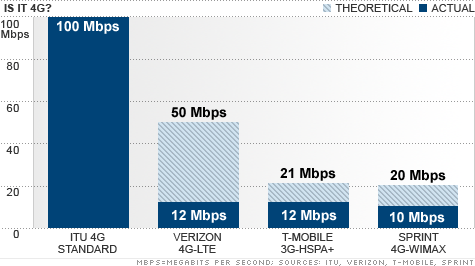
Last year, Sprint was the first wireless carrier to announce a fourth generation (4G) wireless network. T-Mobile came next with what it proclaimed as “America’s largest 4G network.” Then Verizon entered the picture with its own 4G network which they announced as the largest and fastest in the United States. AT&T, of course, eventually released its own 4G network to keep up with the competition, but in hindsight, none of these telecommunications giants have a network that can truly be called 4G. In actuality, what these companies are offering is basically a 3.5G network. A marketing ploy. A hoax…
In November of 2010, the global wireless standards-setting organization, called the International Telecommunication Union, defined 4G as a network that is capable of download speeds of 100 megabits per second (Mbps). While all of the supposed 4G networks out there are clear improvements to the current 3G networks that offer speeds between 500 kbps to 1.5 Mbps, none of them conform to the International Telecommunication Union’s 4G definition. Even more perplexing, each carrier has its own 4G network based on different technologies:
- Sprint offers a 4G network based on Wi-MAX technology.
- T-Mobile offers a 4G network based on an expansion of its 3G-HSPA+ network.
- Verizon offers a 4G network based on Long Term Evolution (LTE) technology.
- AT&T offers a 4G network similar to T-Mobile’s expanded 3G-HSPA+ network and is set to launch their own LTE 4G network sometime this year.
On Wednesday, however, Congress introduced a bill that would hopefully clear up some of the confusion between all of the different 4G offerings. Initiated by the ranking member of the House Subcommittee on Communications and Technology, Rep. Anna Eshoo (D-CA), the Next Generation Wireless Disclosure Act would force wireless carriers to provide specific information about coverage, reliability, speed, pricing, and the type of technology used by the service. A side-by-side comparison of the top 10 competing networks’ speeds and prices would also be available to consumers, and the bill would get the FCC to work with the wireless providers to establish a guaranteed, minimum speed standard for 4G.
With all confusion and technical jargon aside, the bill is a great proposal to help consumers make better choices. Eshoo explained, “Consumers need to know the truth about the speeds they’re actually getting. My legislation is simple?it will establish guidelines for understanding what 4G speed really is, and ensure that consumers have all the information they need to make an informed decision.”
You can learn more about 4G in the video below:
Photo by David Goldman via CNN
